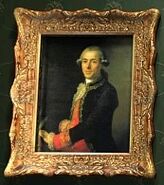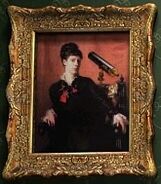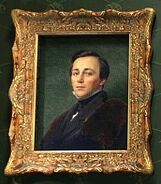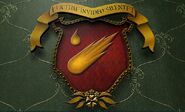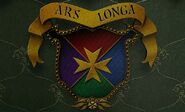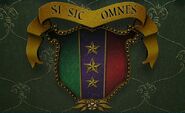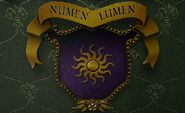The Penvellyns are a wealthy family in London, England who have owned Blackmoor Manor since its creation in the 14th Century. They are rumored to be the protectors of a dark secret.
History[]
In the 14th century, Randulf the Red was awarded the land known as Penvellyn by King Edward III in recognition of his heroism in the Battle of Poitiers. Randulf believed the meteorite he had found previously granted him special strength, and kept it well-guarded and well-hidden deep within the manor he constructed on his new land.
Randulf's son Odo was a better farmer than a warrior, but his grandson Milo proved to be every bit the soldier Randulf was. Randulf believed that this meant that the qualities needed to use the meteorite's power skipped every other generation, beginning a centuries-long tradition of passing the family secret of the space rock from grandparent to grandchild no sooner than the initiate's twelfth birthday. Each initiate would add their own layer of protection to the meteorite so that no one but the proper Penvellyn heir would be able to obtain it. Every initiate would be taught by the Bossiny Family about their ancestry and responsibility.
In the 15th century, Albert Penvellyn built a forge underneath the manor and the rotating rooms in front of it. His grandson Charles realized that grandparents may not always be able to tell their grandchild about the family secret, so he befriended the Bossiny family and swore them to secrecy, hiring them as tutors and tasking them with initiating the Penvellyn heir if the grandparent is unable to. Charles also wove a tapestry that would eventually be displayed in Jane's room and constructed the sliding puzzle above her doorway.
In the 16th century, Thomas Penvellyn constructed a "musical staircase" as well as a puzzle that redirected water to flow into the well of the manor's greenhouse. One day in the 17th century, Thomas's son John discovered an abandoned baby at the manor's doorstep. He adopted her and gave her the name Elinor. Rumors soon spread that she was a "fairy baby", a changeling. Nevertheless, Elinor became an initiate and added a lock to the Mercury column in the manor's great hall, creating a puzzle that would make the Mercury statue James placed in the library release a wand-like key. When Elinor's husband disappeared, the townspeople believed she turned him into the "Beast of Blackmoor" for finding out too much about the family secret. These rumors increased when she forbade anyone from hunting the creature, and she was soon burned at the stake for witchcraft in 1650. The remaining Penvellyns fled to France during this dark time, but by 1715 they were able to return to Blackmoor Manor.
Elinor's grandson Corbin was thought to have lived his entire life in France, but he secretly returned to Blackmoor Manor to perform his duties as an initiate. Corbin installed a gargoyle statue that when turned properly, would open one of the manor's secret passageways that lead straight to a "curse" that he most likely created. He also designed a timed magnet system involving Mercury's wand and the gargoyle statues in order to light the forge.
In the 18th century, Penelope Penvellyn added a lock to the Venus column and placed the arrowhead key in the care of her card game machine, Betty, which she commissioned to be built in 1775. She also added a puzzle in the forge that involved moving a large statue in order to "capture the wind". Her granddaughter Brigitte installed a password on Betty that caused her to give the key out as a prize. Brigitte designed several puzzles on her room that when solved, allow initiates to see an invisible code on her wall. In addition, she locked the moon column and hid its key in her room.
In the 19th century, Edward Penvellyn brought back a dragon statue from one of his travels and modified it so that when its claws were pointing in the proper directions, it would open the eastern secret passageway and a secret slide that concealed the key to the Saturn column. His grandson John locked the Mars column and hid its key with a puzzle on the well based on a short story he wrote. He also brought Loulou back from the Amazon and played a word game with her that inspired him to create a puzzle in one of the passageways involving their game. In 1912, he was presented with The Amateur Plant Hybridizers Association of Great Britain's trophy award for Outstanding Achievement by their president, Maurice Termilliger. John Penvellyn had a love for botany and created many different plants, even carnivorous ones. His granddaughter Leticia Drake inherited his love for botany and enthusiastically took care of all the plants in the conservatory. In the 20th century, Letitia's older brother Alan Penvellyn created a computer program that would trigger a "ghost hunt" puzzle that would give a clue on how to access Edward's hidden slide upon completion.
Curse of Blackmoor Manor[]
The latest Penvellyn heir, Jane, is heartbroken when her parents, Hugh and Renee, divorce. When Hugh remarries a woman named Linda, Jane is determined to get rid of her so her parents can get back together. In between learning school lessons and her duties as an initiate, Jane tricks her stepmother into believing she's transforming into the Beast of Blackmoor.
The Penvellyn Family Tree[]
The main member of the family line is in bold while each initiate -those who protect the family treasure- is also italicized. Siblings are indented.
Jane has a family tree in her room. Her comments about each member of the family are in italics.
Randulf ( - 1401) []
Randulf the Red, so named for his bright red hair, was considered a hero at the Battle of Poitiers. For his heroism, King Edward III awarded him with the lands in the region called "Penvellyn". That's how we got our name.
Randulf's coat of arms says "IN HOC SIGNO" which translates to "in this sign (you will conquer)".
Odo (1354 - 1404) []
Yeah, he isn't very exciting, really. Liked farming and cows. His son Milo is much more interesting.
Odo's coat of arms says "PROSPERITAS" which translates to "success".
- Annor (1356-1379): He was Odo's brother.
- Simon (1358-1411): He lived from 1358 to 1412 - no, 1411. We don't know very much about him.
- Agatha (1361 - 1415): She was a nun. I think she lived in Ireland.
- Margery (1363 - 1371): She died when she was a little girl. It was really sad.
- Guydo (1364 - 1433): He made pizza. No, I'm joking, of course. I don't know anything about him except that he died in 1433 because he outlived all of his siblings.
Milo (1376 - 1423) []
Milo inherited not only his grandfather's red hair but his military prowess. Milo was instrumental in the Siege of Caen and was awarded even more lands by Henry V.
Milo's coat of arms says "VICTUM INVIDEO SILENTE" which translates to "the conquered shall envy the dead".
- Cecilia (1378 - 1450): She married the Lord of Limerick and did a lot of needlework. She had a ton of kids, too. Like 20! Can you imagine?
- Jacobus (1381 - 1390): He died when he was, like, 9.
Hugo (1401 - 1466)[]
Um, he had a lot of kids, and his dates were 1401 to 1466.
Hugo's coat of arms says "CITO FIT QUOD DEI VOLUNT" which translates to "what the gods want happens soon".
Albert (1427 - 1508)[]
He was very mysterious and the people of Blackmoor were afraid of him because he knew all these scientific things. No one knows much about him, though.
Albert's coat of arms says "TIMENDI CAUSA EST NESCIRE" which translates to "ignorance is the cause of fear".
- Josephus (1428 - 1481): Yeah, they used a lot of Latin names back then and weird spellings. He became, like a priest or parson or something.
- Robertus (1428 - 1458): He was a knight but died in some kind of jousting tournament. He was twins with Josephus.
- Lucia (1430 - 1467): Isn't that a pretty name? If I have a daughter, I'll name her that.
- Adam (1431 - 1442): Uh, like he married Eve, duh! No, kidding. I actually don't know anything about him. I think he was the son of Hugo, though, but I forget.
- Anicia (1433 - 1509): A nun.
- Jenet (1435 - 1496): It's 'Jenet' (pronounced Ja-nay). I think he wrote plays, maybe? I dunno, I forget.
- Jone (1435 - 1516): No, that's how they spelled it then. She got married to this Duke somewhere in Flanders.
Edmund (1447 - 1499) []
He was into cows. He did a lot of breeding of cows and sheep and got some kind of award from the King.
Edmund's coat of arms says "UT SEMENTUM FECERIS ITA METES" which translates to "As you sow, so shall you reap".
- Nicholina (1448 - 1501): She died when she was a baby. I have many ancestors who died young, but Ethel said that Penvellyns in general live a long time.
- Walter (1449 - 1471): Um, he was born in 1448, or 9. I'm kind of bored of doing this right now.
- Marge (1451 - 1520): I forget. I think she was...I dunno.
Charles (1478 - 1553)[]
Ooh, ooh - Charles was a very famous judge and wrote very important books on law. But his boy, Garrett, drowned when he was really young.
Charles's coat of arms says "MINIMA MAXIMA SUNT" which translates to "The smallest things are the most important".
Gillian (1501 - 1584)[]
She married the Duke of Balingsford, but she stayed at Blackmoor to raise her son, Thomas, who inherited the estate when his grandfather, Charles, died.
- Garrett (1501 - 1520): He drowned on his 19th birthday.
Thomas (1526 - 1584) []
He was Charles's grandson and wrote a lot of poetry. He also had 3 wives: Catherine, Anne, and Mary. But not like at the same time. They died and he just remarried.
Thomas's coat of arms says "AGE PRO VIRIBUS" which translates to "in all that you do, do your best".
James (1560 - 1650) []
He never married but one day, when he was very old, a baby was found on the doorstep to the manor. He took her in and raised her as his own. That was Elinor.
James's coat of arms says "ARS LONGA" which translates to "art lives long" (from the phrase, ars longa vita brevis - art is long, life is short).
- Francis (1562 - 1604): He got into a big fight with his brother, James, and lived in France.
- Elizabeth (1563 - 1584): Like, the Queen of England? Oh, you mean Elizabeth - my ancestor. It's weird that she's the only ancestor named Elizabeth since it's such a popular name.
- Jeffrey (1565 - 1628): I'd rather not. I'm kind of bored. Wouldn't you rather play a game?
- George (1566 - 1611): Um, he liked lived and died. End of story.
Elinor (1626 - 1650) []
Just that she was burned as a witch but it wasn't true and her father, James, died when he saw her die and then the family fled to France. I don't want to talk about this.
Elinor's coat of arms says "AUDACES FORTUNA IUVAT" which translates to "fortune favors the bold".
Edward (1646 - 1704) []
He lived in France with his father, Le Comte de Roquefort. He was very interested in languages and translated books from Greek and Latin.
- Virginie (1648 - 1666): She was married to the Duke of Barrowbold and died in the Great Fire of London.
- Francois (1649 - 1710): He was a dwarf and became a trusted confidant to Louis XIV. Little people often held positions of great esteem at that time.
Corbin (1670 - 1741) []
Uh...I dunno. He doesn't have a coat of arms in the Great Hall because he didn't live here; wasn't even a British subject. That's all I know.
Corbin's coat of arms says "NUNQUAM DEDISCEO" which translates to "never forget".
- Helene (1673 - 1760): *Sigh* Can we stop soon? Helene married the Duke of Boueville and died in 1760. End of story.
- Frederic (1674 - 1702): He was a soldier- for the French. He was killed in the war of Spanish Succession in July of 1702.
- Colin (1677 - 1701): Oh, this is so, so cool. They say he was a spy for England even though he lived in France. Isn't that so very? I'd like to be a spy.
Philippe (1689 - 1777) []
He made a fortune in the New World and bought back most of the lands that were confiscated by Cromwell.
Philippe's coat of arms says "NOVUS MUNDUS" which translates to "a new world".
- Theophile (1690 - 1781): He lived most of his life on the island of Mauritius and discovered, like, a million plant species.
- Brigitte (1691 - 1789): She was absolutely mad about cricket - the game, not the insect. She actually saw the first cricket match in 1744. Personally, I can't stand the sport.
Penelope (1714 - 1783) []
I don't know very much about her, except that she was very loved by practically everyone in England, and there were a million poems written about her. If I have a boyfriend, I'd never let him write a poem about me. Blech.
Penelope's coat of arms says "PULCHRITUDO IN OMNIA" which translates to "there is beauty in all things".
- George (1715 - 1751) and Henri (1717 - 1751): They were lost at sea. I guess they traveled a lot to Canada, especially to Oak Island.
- Marianne (1720 - 1789): Um, she got shipwrecked on this deserted island with a whole bunch of yahoos and they wrote a story about it. Yeah, that's it.
- Jean (1722 - 1741): Hello- it's pronounced 'Jean' (John). He was killed by a boar on a hunting trip. They eat people's flesh, you know. No, I'm kidding. But he really did get eaten by a boar. Serves him right, though, for hunting some poor little animal.
Martha (1739 - 1791) []
She was completely daft - she'd wear really bizarre outfits and she was one of the first women to ride on a steam train.
Martha's coat of arms says "SINE SCIENTIA ARS NIHIL EST" which translates to "without understanding, art is nothing".
- John (1741 - 1782): He was an opera singer, just like my mum. He sang in some Mozart operas, I think.
Brigitte (1759 - 1833) []
She never married and was bonkers for astronomy; she adopted her sister's son, Richard, who later got killed at Waterloo.
Brigitte's coat of arms says "LUDI SINE GAUDIO LUDI NON SUNT" which translates to "sport without fun is not sport."
There is also a song sung by Ethel and Jane duing their studies about her, you can hear it sometimes passing Jane's room. It goes, "Brigitte with her eyes so bright, looks toward heaven at midnight on the longest night of year, that's the one she holds most dear. 'Starry friends,' she's often heard to say, 'how I wish that I could make you stay.' She knows though they can't remain, time will bring them 'round again."
- Peter (1762 - 1804): Um, let's see - he had a wooden leg and he was attacked by wolves once. That's all I remember.
- Isabelle (1763 - 1801): That was Isabelle. She wrote many letters about the French Revolution and actually saw Marat's dead body in the bathtub. Talk about gross!
- Jacques (1764 - 1841): Don't laugh, but he invented the lawnmower bag in 1831. I swear, I'm totally not making this up.
Richard (1787 - 1815) []
He died in Waterloo fighting against Napoleon.
Richard's coat of arms says "SI SIC OMNES" which translates to "if only this could last forever".
Edward (1809 - 1904) []
He was a big explorer and went all over the world. He wasn't very close with his son, who was also an explorer. They'd only see each other by chance in weird remote places like Samarkand or Walla Walla.
Edward's coat of arms says "BIS VIVAT QUI BON VIVAT" which translates to "Whoever lives well lives twice".
- Caroline (1810 - 1844): Caroline was a chemist and helped identify the element lanthanum. I'm not sure what the element does. I think it's a heavy metal.
- William (1811 - 1814): He was Edward's little brother. He named his son after him.
William (1833 - 1901) []
He was an explorer, just like his father. He was kind of a whiner, so I heard.
William's coat of arms says "DIES PERDIDI" which translates to "another day wasted".
- Cassandra (1834 - 1903) and Hector (1834 - 1882): Uh huh. Cassandra was totally obsessed with lawn tennis and was one of the first people in England to have a court installed in her home. Hector was the first ball boy.
- Sophia (1838 - 1909): She was a big collector of Impressionist artwork, but most of it was destroyed in a fire.
- Arthur (1840 - 1910): He lived in the wild west in the Americas and was a bandit with El Diablo's gang!
- Cynthia (1850 - 1949): I don't know. I'm kind of tired right now.
- Catherine (1851 - 1952): She lived the longest of any Penvellyn. I hope I live that long, but not if I'm all like creaky and cranky.
- Rose (1855 - 1941): It's a real sad story. She and her granddaughter, Rachel, lived in France during the War and were killed.
John (1873 - 1954) []
He was this huge naturalist and did a lot of exploration in the Amazon. I think there's a plant named after him. Or maybe a monkey; I forget.
John's coat of arms says "PER AURES AD ANIMUM" which translates to "through the ears to the spirit".
Malachi (1894 - 1972) []
He was a doctor of medicine and did a lot of research on icky skin diseases. Happily, I'm blessed with perfect skin.
Malachi's coat of arms says "NUMEN LUMEN" which translates to "divine light is my guide".
- Obadiah (1895 - 1975): He lived in the US for most of his life and married this weird woman named Eustacia. She's still alive and sometimes calls us - she's totally creepy.
- Rachel (1895 - 1941): She died in France during the war. I guess she worked for the French resistance.
- Esther (1897 - 1951): *Sigh* Esther Penvellyn Romberg, born in 1897 and died in 1951. Her friends called her Polly.
- Nahum (1898 - 1911): He died in the flu epidemic.
Alan (1923 - 1993) []
He was my grandfather but I didn't know him because he died when I was little. I guess he was nice.
Alan's coat of arms says "PURGAMENTUM EXIT" which translates to "garbage out" (referencing part of a programmers' saying "garbage in, garbage out").
- Nigel Mookerjee mentions that "Alan Penvellyn was a noted researcher in computers and languages."
- Leticia (1925 - ): Loves plants, hates noise. You can ask her about it. She's usually in the conservatory with her plants.
Penvellyn Library[]
Nigel Mookerjee knows much about the Penvellyns and the books in their library.
- Law Books (16th Century): I doubt you'll find much of interest in there; they're mainly law books. Charles Penvellyn was a prominent judge in the 16th century. Sad to say, he lost his son at a young age. Left his estate to his grandson, Thomas.
- Novels (18th Century): Those are mainly Penelope Penvellyn's collections of French novels. She was a patron to a raft of artists, and her salon was quite popular. She was quite the libertine, even kept her maiden name after her marriage.
- Old Manuscripts (14th and 15th century): Those Manuscripts are very old and brittle. They date back to the 14th century. Odo Penvellyn collected most of them. His father Randulf and son Milo were rather more interested in military victories than in book collecting.
Trivia[]
- Unlike other families that just have a single coat of arms, each member of the Penvellyn family creates their own. The initiated ones usually hide a clue to discovering the family treasure in theirs.
- In Secrets Can Kill: Remastered, John Penvellyn's book Grenny and the Water Fairy can be found through the library search engine. In addition, Charles Penvellyn's book The Journal of Charles Penvellyn can also be found.
- Some of the pictures used for the family members appear reused from pictures of actual historical figures. Specifically:
- Thomas Penvellyn's portrait is the portrait of Pierre Quthe, a French apothecary.
- James Penvellyn's portrait is the portrait of Jean Daret, a Flemish artist.
- Corbin Penvellyn's portrait is the portrait of John Locke, an English philosopher.
- Penelope Penvellyn's portrait is the portrait of Madame Freret Dericour, an unknown French lady.
- Martha Penvellyn's portrait is the portrait of Gertrude Agnew, the wife of a British parliament member.
- Richard Penvellyn's portrait is the portrait of Karl Nesselrode, a foreign minister of the Russian Empire.
- Malachi Penvellyn's portrait is the portrait of Lord Dalhousie, an unknown art subject, although the head appears to have been changed.







